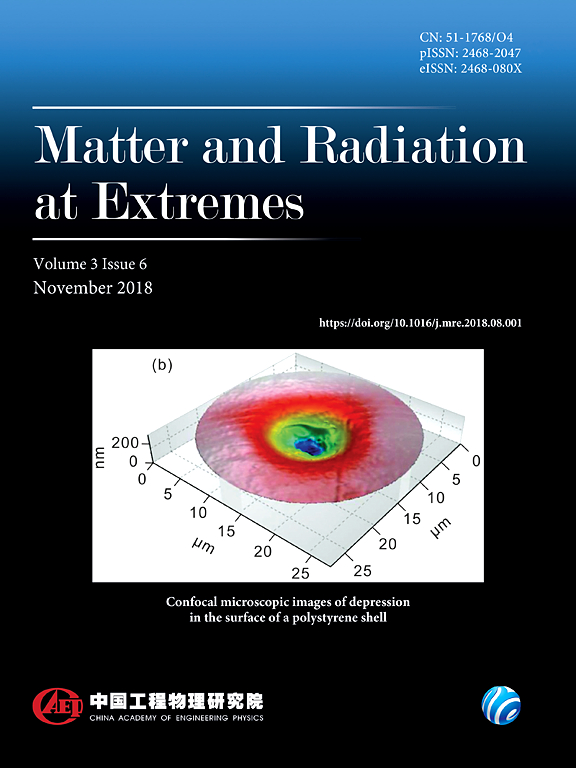Collisionless shock acceleration of protons in a plasma slab produced in a gas jet by the collision of two laser-driven hydrodynamic shockwaves
IF 4.7
1区 物理与天体物理
Q1 PHYSICS, MULTIDISCIPLINARY
引用次数: 0
Abstract
We have recently proposed a new technique of plasma tailoring by laser-driven hydrodynamic shockwaves generated on both sides of a gas jet [Marquès et al., Phys. Plasmas 28, 023103 (2021)]. In a continuation of this numerical work, we study experimentally the influence of the tailoring on proton acceleration driven by a high-intensity picosecond laser in three cases: without tailoring, by tailoring only the entrance side of the picosecond laser, and by tailoring both sides of the gas jet. Without tailoring, the acceleration is transverse to the laser axis, with a low-energy exponential spectrum, produced by Coulomb explosion. When the front side of the gas jet is tailored, a forward acceleration appears, which is significantly enhanced when both the front and back sides of the plasma are tailored. This forward acceleration produces higher-energy protons, with a peaked spectrum, and is in good agreement with the mechanism of collisionless shock acceleration (CSA). The spatiotemporal evolution of the plasma profile is characterized by optical shadowgraphy of a probe beam. The refraction and absorption of this beam are simulated by post-processing 3D hydrodynamic simulations of the plasma tailoring. Comparison with the experimental results allows estimation of the thickness and near-critical density of the plasma slab produced by tailoring both sides of the gas jet. These parameters are in good agreement with those required for CSA.两个激光驱动的流体动力冲击波碰撞产生的等离子体板中质子的无碰撞冲击加速度
我们最近提出了一种通过激光驱动的流体动力冲击波在气体射流两侧产生等离子体裁剪的新技术[Marquès 等人,Phys. Plasmas 28, 023103 (2021)]。作为这项数值工作的延续,我们在实验中研究了三种情况下裁剪对高强度皮秒激光驱动质子加速的影响:无裁剪、仅裁剪皮秒激光的入口侧以及裁剪气体射流的两侧。在没有裁剪的情况下,加速度横向于激光轴,具有库仑爆炸产生的低能量指数谱。当对气体射流的前侧进行裁剪时,会出现向前的加速度,当对等离子体的前后两侧都进行裁剪时,加速度会显著增强。这种前向加速产生了能量更高的质子,其光谱呈峰值状,与无碰撞冲击加速(CSA)机制非常吻合。等离子体剖面的时空演变是通过探针光束的光学阴影成像来描述的。通过对等离子体裁剪的三维流体力学模拟进行后处理,模拟了光束的折射和吸收。通过与实验结果进行比较,可以估算等离子体板的厚度和近临界密度。这些参数与 CSA 所需的参数十分吻合。
本文章由计算机程序翻译,如有差异,请以英文原文为准。
求助全文
约1分钟内获得全文
求助全文
来源期刊

Matter and Radiation at Extremes
Physics and Astronomy-Atomic and Molecular Physics, and Optics
CiteScore
8.60
自引率
9.80%
发文量
160
审稿时长
15 weeks
期刊介绍:
Matter and Radiation at Extremes (MRE), is committed to the publication of original and impactful research and review papers that address extreme states of matter and radiation, and the associated science and technology that are employed to produce and diagnose these conditions in the laboratory. Drivers, targets and diagnostics are included along with related numerical simulation and computational methods. It aims to provide a peer-reviewed platform for the international physics community and promote worldwide dissemination of the latest and impactful research in related fields.
 求助内容:
求助内容: 应助结果提醒方式:
应助结果提醒方式:


